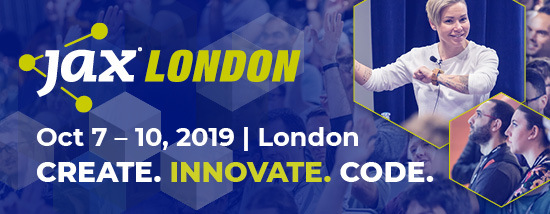JAXenter: Hello Martin and thanks for taking the time to talk to us. OpenShift is not an unknown container platform, but would you mind summarizing the basic functionality for our readers?
Martin Klaus: Red Hat OpenShift is one of the most popular container and Kubernetes platforms on the market today. In essence, OpenShift provides all the capabilities for IT operations teams to deploy and manage containerized applications including the Kubernetes distribution itself, but also the container runtime, storage and networking capabilities, logging and management, authentication and security capabilities.
For application developers, OpenShift provides a broad range of developer tools including build automation, release pipelines, and project management capabilities that tightly integrate with the Kubernetes foundation. Additionally, OpenShift supports a broad range of application runtimes, databases and newer technologies like service mesh and Knative-based serverless capabilities. Our goal with OpenShift is to empower developers to innovate and make the application development process as frictionless as possible for traditional applications all the way to cloud-native applications. To do that, we offer CodeReady Workspaces, which is an Eclipse Che-based web IDE, but also integrations with Visual Studio Code, and many other popular developer tools including command line.
Today, OpenShift is used by more than 1,000 enterprise customers worldwide across many industries like financial services, retail, energy, automotive and manufacturing, and helps those organizations differentiate their business by building applications faster. We’re seeing use cases around DevOps, app modernization and cloud-native development, but also emerging use cases around analytics and AI workloads, which are exciting because they help customers in their respective industries innovate with new functionality that provides a better end user experience.
JAXenter: How does OpenShift differ from other platforms like Rancher or – as the most prominent example – Kubernetes?
Martin Klaus: In general I would say there are a few key reasons why so many customers have chosen OpenShift as their container and Kubernetes platform. This momentum and being recognized as a leader by industry analysts is a big differentiator. With OpenShift we are very fortunate to have customers speak publicly about the success they’re having, which also includes many of Red Hat’s middleware products, management, storage and services capabilities like the Red Hat Open Innovation Lab as well as partner solutions from traditional ISVs and all the major cloud providers.
Second, Red Hat has been an early supporter of Kubernetes and provides the most code contributions to the community second only to Google, who started the development of the project in the first place. So we are making a huge engineering commitment to the Kubernetes community and about two dozen other projects like Prometheus, etcd, CRI-O, Knative and many others that ultimately make up the OpenShift platform. Open source leadership is actually very important to enterprise customers because it allows them to rely on their vendor, in this case Red Hat, to support them long term in terms of code fixes, security patches and helping them get code contributions accepted by the community.
Third, OpenShift provides a very comprehensive platform that supports many of the applications and use cases that arise when customers deploy OpenShift in their own data center or as a common application platform across one or multiple cloud providers. This means that every time an upstream release comes out we spend the time to test hundreds of infrastructure, cloud and application configurations to make sure nothing breaks when you deploy the software at scale. Typically this process helps flush out about one to two hundred issues that we fix and provide back to the community.
And last but not least, the broad ecosystem of ISV partners and cloud providers that offering solutions around OpenShift is very exciting to see as well and how that has been building a lot of momentum. For example, Microsoft released Azure Red Hat OpenShift which is a jointly developed service of OpenShift on the Azure platform. The OperatorHub is a collection of Operator-enabled partner products that are designed to offer value add capabilities on the OpenShift platform. And many of the global system integrators like Atos, DXC, and T-Systems offer OpenShift-based services to our joint customers.
We’re also seeing a very healthy and thriving Operator ecosystem that is expanding day by day.
JAXenter: OpenShift 4 is the latest major release. What are your personal highlights of the new version?
Martin Klaus: Red Hat OpenShift 4 is designed to deliver a cloud-like experience across the hybrid cloud by driving automated updates across Kubernetes deployments everywhere. There are several highlights in OpenShift 4, but let me focus on the ones that we believe are the most differentiating and exciting for customers.
First, we’ve completely simplified and automated the OpenShift installation, update and upgrade experience. OpenShift can now manage compute nodes and manage the entire stack from the hardware and Linux OS on up, add new nodes to the cluster automatically or scale back down, and update the platform with what we call over-the-air updates. You can be up and running in 15 minutes and update to the latest release with a single click. We accomplish that with Red Hat Enterprise Linux CoreOS, which is an immutable, image-based and container optimized version of RHEL that OpenShift can manage directly. But we still support also traditional RHEL 7 deployments when customers have existing infrastructure in place already.
Another big innovation is what we call Kubernetes Operators. Operators are code that automate day-two management tasks such as updating a component, rebalancing a database, or restoring services that have been affected by an outage. You can think of Kubernetes Operators as a software-defined IT admin that ships with an application or an infrastructure component and always compares current state with desired state and then automatically takes corrective action if needed. Operators are implemented as custom resource definitions (CRDs) and are therefore a native Kubernetes capability. So we’re using Kubernetes itself to manage the container platform and stateful apps. Operators are a very powerful construct and we haven’t scratched the surface yet in terms of what’s possible with Operators, including lifecycle management, consumption-based metering, etc.
For developers, we’re excited about the many new tools and integrations with their preferred IDEs, and in particular, CodeReady Workspaces that makes it very easy to program as a team and build applications on the OpenShift platform.
We’re also excited about our partnership with Microsoft. At Red Hat Summit, Microsoft CEO Satya Nadella announced the general availability of the Azure Red Hat OpenShift service which we’ve built together with Microsoft and is the first jointly developed and hosted service of its kind. Azure is a very popular cloud platform for developers and we believe that a native Azure OpenShift service provides the best experience for developers who want to build containerized applications on the Azure platform along with all the other Azure services that are available to them.
SEE ALSO: OpenShift 4 arrives with Kubernetes at its core
JAXenter: What challenges has the development of OpenShift 4 brought with it? What were you worried about during development?
Martin Klaus: What’s unique about Red Hat is that we use an open source development model to deliver enterprise software products. All our development is done in open source communities, which is actually a very difficult thing to do. Unlike companies who use a closed source model or who simply package and distribute code, we need to work with communities every day to align on architecture, implementation details, code fixes, and so on. In a healthy open source community no one entity can dictate how things get done. Development is consensus-driven, which means development timelines become much harder to predict. On the flip side, this community development model ultimately leads to much better design decisions, more flexibility and customization options and better code quality. But when the community declares a release is ready we’re not done yet and continue to harden, test and validate before we declare general availability of our products and releases that we support for many years. Any fixes we apply in our products during this hardening process we provide back to the community which has already moved on to the next release.
JAXenter: Is there already a roadmap for the next major release? What features are you planning for OpenShift 5?
Martin Klaus: It is still a bit early to talk about the next major release that might be few years out. But in general, there are a few exciting areas we’re working on. Obviously, supporting OpenShift on as many cloud and data-center platforms as possible to deliver on our open hybrid cloud vision is job 1. We’re also seeing a very healthy and thriving Operator ecosystem that is expanding day by day. If you look at the Operatorhub.io site, which is a community site of curated Operators that meet certain quality standards, it really has become the one place to go to for developers to publish operators or for anyone to see what’s out there. Beyond that, I would expect more focus on AI and machine learning workloads on OpenShift. This is already a fast growing use case with many customers speaking at OpenShift Commons Gatherings or Red Hat events how they’re using OpenShift to analyze medical images to detect brain tumors or to accelerate the early detection of sepsis. We’re also seeing interest in what we call Kubernetes-native infrastructure which is essentially a more simplified architecture of the entire IT stack that starts with Kubernetes on bare-metal hardware and then uses KubeVirt as a way to provide backwards compatibility with existing VMs that run side by side with containerized applications. And lastly, federation and multi-cloud management is another area where we should see a lot of movement in the near future to make that a reality for our customers.
SEE ALSO: “The power of Kubernetes & OpenShift lies not only in the capabilities but also in the broad ecosystem of products”
JAXenter: Following the acquisition of Red Hat by IBM, there has often been a discussion that working on hybrid cloud technologies should be the core objective of collaboration between companies. Is OpenShift at the heart of these efforts?
Martin Klaus: The acquisition is still under regulatory review and hasn’t officially closed yet. Powered by IBM, Red Hat can dramatically scale and accelerate what we are doing today. We will have greater resources to grow into the opportunity ahead of us, be able to invest even more and faster to accelerate open source innovation in emerging areas, be able to reach all corners of the world with even deeper customer and partner relationships than we have today and help even more customers benefit from the choice and flexibility afforded by hybrid and multicloud technologies. Joining forces with IBM offers all of that, years ahead of when we could have achieved it alone. Together Red Hat and IBM can become *the* leading hybrid cloud solutions provider.
JAXenter: Finally, maybe the question about the satellite projects of OpenShift, i.e. OpenShift Online, OpenShift.io, and OpenShift Origin. What’s new there, what’s planned?
Martin Klaus: What’s important to recognize is that OpenShift is a platform that can be deployed or “consumed” in many different ways based on customer preferences. In essence, you can deploy OpenShift on your own. OpenShift Container Engine and OpenShift Container Platforms are the two offerings that enterprise IT organizations can choose from if they want to take a first step towards containers and Kubernetes with Engine or a complete platform. But increasingly we’re seeing interest in our hosted services called OpenShift Dedicated if the backend is AWS or Google Cloud, or Azure Red Hat OpenShift if customers prefer Microsoft as the underlying cloud provider. Additionally, OpenShift Online is a service we make available to developers directly if they want to get started on their own. Beyond these core offerings, our portfolio also includes OpenShift Container Storage and Red Hat Quay which is our enterprise container registry.
Thanks a lot!
The post OpenShift 4 interview: “Operators are a very powerful construct” appeared first on JAXenter.
Source : JAXenter



















